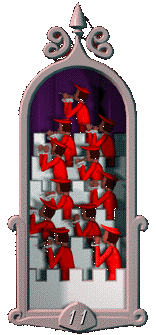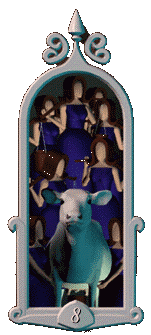 Today it begins, our eighth annual “Twitcast” joining pro-life bloggers from near and far, who all had the good sense once again, to come in out of the cold during the annual March For Life, for this year's ProLifeCon, the “premiere conference for the online prolife community” hosted once again by the Family Research Council in Washington DC.
Today it begins, our eighth annual “Twitcast” joining pro-life bloggers from near and far, who all had the good sense once again, to come in out of the cold during the annual March For Life, for this year's ProLifeCon, the “premiere conference for the online prolife community” hosted once again by the Family Research Council in Washington DC. During the event, this video clip provides a live feed of the proceedings. With its conclusion, you are invited to view the full pre-recording (which begins at 8:37). You can learn more at the FRC website, follow the magic hashtag on Twitter: #prolifecon, or follow yours truly at: twitter.com/manwithblackhat.
The list of speakers announced two days prior to the event (not necessarily in order of appearance) are as follows:
Brandon Buell, Father of Jaxon "Strong" Buell, Co-Author, Don't Blink, and Co-Trustee for The Jaxon Strong Foundation
Rebekah Buell, Pro-Life Speaker & Abortion-Reversal Mother
Arina Grossu, Director, Center for Human Dignity, Family Research Council
Kelsey Harkness, Senior News Producer, The Daily Signal
Kristan Hawkins, President, Students for Life America
Anna Hoduski, Campaign Speaker & Runner, Project If Life
Rep Randy Hultgren (R-IL)
Bishop Vincent Mathews, Jr, President of the International Missions Department, The Church of God in Christ
Melissa Ohden, Author, “You Carried Me: A Daughter’s Memoir”
Tony Perkins, President, Family Research Council
Brandi Swindell, Founder and President, The Stanton Project
Rep Claudia Tenney (R-NY)
A transcript of the Twitter feed will appear below once the event is completed. Items may be edited slightly for correction, especially when we have to look up some of the big words.
+ + +
"Good morning to our online viewers ..." #prolifecon
8:30 AM
Vice President Pence will be appearing at the Rally of the #MarchForLife. This is unprecedented. #prolifecon
8:31 AM
Kristan Hawkins, President, Students for Life America. #prolifecon
8:32 AM
Learned of her son's serious illness. "How can I make sure that [his] life is a fulfilled life?" #prolifecon
8:33 AM
"You live an extraordinary life when you live to serve others." #prolifecon
8:33 AM
"This is a crazy life we have as #ProLife activists ... we need a new generation of heroes ... you can be that hero online." #prolifecon
8:35 AM
"We are called to witness to the truth, that we don't need Planned Parenthood anymore." #prolifecon
8:38 AM
Lauren Merz, LiveAction. #prolifecon
8:43 AM
Despite playing it down, Planned Parenthood performs 30 percent of the abortions in America. "They *are* an abortion business." #prolifecon
8:45 AM
"We contacted Planned Parenthood locations in search of prenatal care here." #prolifecon
8:46 AM
"We contacted 97 locations. Only 5 offered prenatal care." #prolifecon
8:48 AM
Rebekah Buell, Pro-Life Speaker & Abortion-Reversal Mother. #prolifecon
8:49 AM
"I became pregnant at 17. I was scared and I was shocked. I lived in a Baptist home where we never talked about sex." #prolifecon
8:50 AM
"I needed to get out of an abusive relationship. And then I found out that I was pregnant again. I considered an abortion." #prolifecon
8:51 AM
"I visited a clinic close to my university (in Sacramento)." #prolifecon
8:52 AM
"I was told: 'We don't give the abortion pill on Fridays.'" #prolifecon
8:53 AM
Went to Planned Parenthood, who kept putting her off for a couple of weeks. Finally got the RU-486 pill. #prolifecon
8:55 AM
Was given an additional pill, was not told of its full effects, or that it was normally given while in labor. #prolifecon
8:56 AM
Had a change of heart, sought out a #ProLife doctor for a procedure of reversing the process. #prolifecon
8:57 AM
PP kept calling, told her that the reversal would create health risks. #prolifecon
8:58 AM
The second child was born, now one of an estimated 300 reversed procedures. #prolifecon
8:59 AM
Brandi Swindle, Founder and President, The Stanton Project. #prolifecon
9:00 AM
"Could we possibly replace Planned Parenthood?" #prolifecon
9:01 AM
Congress is seriously considering defunding Planned Parenthood. #prolifecon
9:02 AM
Cosmopolitan ("Cosmo") did a feature piece on the The Stanton Project. It was a wonderful piece. #prolifecon
9:03 AM
"We have bought property on each side of one Planned Parenthood location in Idaho. A church is being built on the other plot." #prolifecon
9:05 AM
"Planned Parenthood is suing us, in part for parking our mobile clinic in front of our own property, next door to them." #prolifecon
9:07 AM
The "March for Women" on the 21st tried to kick them out. They marched anyway. #prolifecon
9:08 AM
thestantonproject.org #prolifecon
9:11 AM
Congressman Randy Hultgren, Republican from Illinois. #prolifecon
9:15 AM
"Where I get so encouraged by the #MarchForLife, it's with the number of young people ..." #prolifecon
9:17 AM
Discussed a bill to ensure more transparency in how taxpayer funding will be used for health care services. #prolifecon
9:19 AM
President Trump will announce his next nominee for the Supreme Court at the upcoming National Prayer Breakfast. #prolifecon
9:24 AM
"We can have an impact [on doing the right thing] in the next four to six months, in the next four years." #prolifecon
9:27 AM
"I grew up in Wheaton, Illinois. Henry Hyde was my congressman. He was my hero." #prolifecon
9:31 AM
"We are now going now to the National Mall for a live report from Brent." #prolifecon
9:33 AM
Brandon Buell, Father of Jaxon "Strong" Buell, Co-Author, Don't Blink, and Co-Trustee for The Jaxon Strong Foundation. #prolifecon
9:34 AM
A short video clip of young Jaxon. #prolifecon
9:37 AM
"I come to you today as a father, because a *man* who stands up for these values is so rare." #prolifecon
9:39 AM
"Every day I strive to be a better husband, and a better father." #prolifecon
9:39 AM
There was so little information available on Jaxon's condition, many parents didn't make the decision to bring a child to term. #prolifecon
9:43 AM
facebook.com/WeAreJaxonStrong/ … #prolifecon
9:44 AM
jaxonstrong.com #prolifecon
9:44 AM
"We are called a hate group." ("Men will hate you because of me." - Jesus Christ) #prolifecon
9:52 AM
"I wanna talk for a second about my wife." #prolifecon
9:52 AM
Jaxon and Mom are introduced to the stage. #prolifecon
9:54 AM
"For I know the plans I have for you, says the LORD." #prolifecon
9:55 AM
Congresswoman Claudia Tenney, Republican from New York. #prolifecon
10:06 AM
The congresswoman is speaking by video stream from a bus en route to the #MarchforLife2017. "We're 20 minutes out." #prolifecon
10:08 AM
Melissa Ohden, Author, "You Carried Me: A Daughter’s Memoir." #prolifecon
10:09 AM
Melissa is a survivor of a failed saline abortion. #prolifecon
10:10 AM
"We've got 109,000 views now (at #prolifecon)."
10:11 AM
Founder of the Abortion Survivors Network. #prolifecon
10:12 AM
"I would encourage you to continue to move beyond your comfort zone." #prolifecon
10:14 AM
CMP videos, defunding Planned Parenthood efforts and hearings, survivors testifying. #prolifecon
10:16 AM
"Post about where you are, add photos and video, as it's happening, tag others." #prolifecon
10:18 AM
"Videos and music make a strong impact and are shared frequently." #prolifecon
10:19 AM
"I often say the personal is political, the political is personal." #prolifecon
10:20 AM
"Live streaming of hearings and events such as FRC's lecture series popular with lots of initial viewers and shares." #prolifecon
10:21 AM
"Be relevant. Pick up what is happening or reflect upon a historical significance." #prolifecon
10:22 AM
"Be willing to go mainstream, look for opportunities. If you see a pro-life story, share it, comment on it, share information." #prolifecon
10:24 AM
"You Carried Me" is a book by Melissa Ohden. #prolifecon
10:25 AM
Kelsey Harkness, Senior News Producer, The Daily Signal. #prolifecon
10:28 AM
First, a video is shown featuring Kelsey talking about the March. #prolifecon
10:29 AM
"Organizers of the Women's March formed a very progressive platform" excluding some women's voices, including #prolife women. #prolifecon
10:32 AM
"We needed to get ahead of the narrative, so we had two days to produce that video." #prolifecon
10:34 AM
"The #prolife movement is far more diverse than I ever imagined growing up in Connecticut." #prolifecon
10:35 AM
Saw this clip. The reporter definitely got schooled! trib.al/y1bqz8s #prolifecon
10:37 AM
"Many people don't understand how far along in a pregnancy a woman can have an abortion." #prolifecon
10:47 AM
Congressman Jim Banks, Republican from Indiana. #prolifecon
10:48 AM
Thanks to @FRC as an important resource for freshman members of Congress. @prolifecon
10:49 AM
Governor Pence was the most #ProLife governors in Indiana history. #prolifecon
10:50 AM
Bishop Vincent Mathews, Jr, President of the International Missions Department, The Church of God in Christ. #prolifecon
10:52 AM
"There is a demonic spirit of deception about what the Bible teaches." #prolifecon
10:55 AM
"You’re going to have a lot of people coming on Friday.” #prolifecon
10:56 AM
"If you don't want these children, we will take them into our homes." #prolifecon
10:57 AM
"We [use mobile apps to] engage others in intercessory prayer. You can't hate someone you're praying for." #prolifecon
11:00 AM
familylifecampaign.org #prolifecon
11:01 AM
The notion of a "black church" and a "white church" is "oxymoronic." #prolifecon
11:03 AM
"It's up to the Church of Jesus Christ, not the government, to show the world what the real issues are." #prolifecon
11:06 AM
Catherine Szeltner, Host of EWTN ProLife Weekly. #prolifecon
11:08 AM
Communication is two way, not only in how a message is presented, but in how people can respond, as in a one-on-one encounter. #prolifecon
11:14 AM
"Be prepared to answer the question, why are you #ProLife?" #prolifecon
11:15 AM
Thomas Jacobson, Global Life Campaign, presents a summary of an "Abortion Worldwide Report." #prolifecon
11:19 AM
Anna Holduski, Campaign Speaker & Runner, Project If Life #prolifecon
11:27 AM
projectif.life #prolifecon
11:29 AM
"Thank you for joining and sharing your talents." #prolifecon
11:31 AM
.... and we're out! #prolifecon
11:31 AM
+ + +
This year's edition, as with those in the past, will be updated with additional content over the next 24 hours. While the general sentiment of this year's March is the most optimistic in many years, with the unqualified support of both President Trump and Vice President Pence, this year's ProLifeCon had a lower turnout than usual, which was most unfortunate. Not only that, but at least four of the speakers were not on the original schedule, which made it difficult to provide correct information for the Twitter feed in real time. And so, corrections to the original transcript have been made, and this writer's concerns were addressed to the management of the Family Research Council, which was most receptive. It is hoped that an updated list will be provided to participants prior to the event.

















